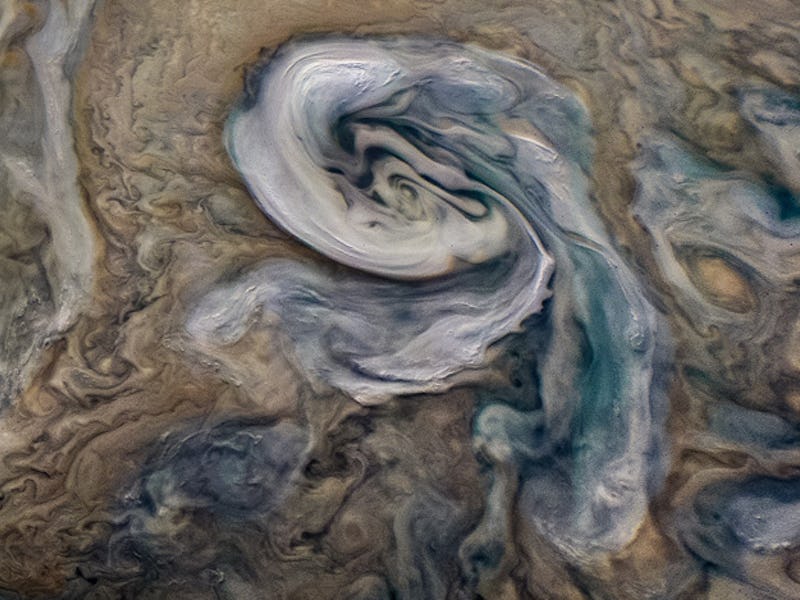Jupiter's bizarre, hellish weather just got a little weirder — study
"Great, it's hailing mush balls again."

If you're planning a trip to Jupiter, you might want to check the weather app. The giant gas planet hosts violent storms that last for hundreds of years, freezing temperatures that dip below 200 degrees Fahrenheit and icy clouds.
Adding to this weather that's right of a comic book, scientists have announced they discovered a new climate phenomenon that takes place on Jupiter, ammonia hail. They even have a name: mush balls.
The discovery is detailed in a series of three papers published Wednesday in the journal Nature, Journal of Geophysical Research and JGR Planets.
The Juno spacecraft captured violent thunderstorms on Jupiter, which may result in ammonia rich hail.
Using observations by NASA's Juno mission, scientists discovered inconsistencies with — a colorless gas that is made up of nitrogen and hydrogen atoms — on the planet Jupiter. Ammonia is rich in Jupiter's equator but is less abundant elsewhere.
In order to help them understand the variability in the presence of ammonia on Jupiter, the team of researchers behind the new study developed an atmospheric mixing model for the gas giant.
The model suggested that Jupiter's thunderstorms cause the formation of hail that is rich in ammonia.
The thunderstorms of Jupiter take place in regions on the planet where temperatures reach below 150 degrees Fahrenheit and therefore water exists in three forms, liquid, water vapor and ice. It's so cold in those regions that the thunderstorms carry water ice crystals into Jupiter's upper atmosphere.
According to the first study, the water ice crystals react with the ammonia gas in Jupiter's atmosphere and turn into liquid, which turns them into a full-on ammonia hailstorm.
The scientists behind the discovery dubbed the ammonia hail as "mush-balls."
These mush-balls explain the ammonia variability across Jupiter. The second study states that the ammonia mush-balls are heavier, and therefore fall deeper into Jupiter's atmosphere until they evaporate, which results in the presence of ammonia and water in that part of the planet's atmosphere.
Meanwhile, the third study reveals a new phenomenon that the spacecraft Juno was able to observe for the first time, small lightning storms that appear as bright spots on the top of Jupiter's clouds. Due to Juno's close proximity to the planet, the spacecraft was able to detect these smaller flashes that take place on shallower areas of Jupiter while other observations have only noted larger storms taking place in deeper regions of the planet.
These smaller, shallow flashes of lightning take place at the same areas where the ammonia mush-balls abound.
Juno launched in 2011. One of the mission’s main objectives is to determine how much water is in Jupiter’s atmosphere. Doing so will give scientists a better understanding of how planets formed early on in the Solar System.
The spacecraft orbits Jupiter every 53 days, using its Microwave Radiometer instrument to observe the planet from above. The tool features six antennas that measure atmospheric temperature at multiple depths simultaneously. Because both water and ammonia absorb microwave radiation, these temperature measurements show their abundance in Jupiter’s atmosphere.
Understanding Jupiter's climate and meteorology is not only telling of the Solar System's largest planet, but it can also help scientists better understand the formation and evolution of gas giants that exist beyond the confines of the Solar System.
Abstract: Observations of Jupiter's deep atmosphere by the Juno spacecraft have revealed several puzzling facts: The concentration of ammonia is variable down to pressures of tens of bars and is strongly dependent on latitude. While most latitudes exhibit a low abundance, the Equatorial Zone of Jupiter has an abundance of ammonia that is high and nearly uniform with depth. In parallel, the Equatorial Zone is peculiar for its absence of lightning, which is otherwise prevalent most everywhere else on the planet. We show that a model accounting for the presence of small‐scale convection and water storms originating in Jupiter's deep atmosphere accounts for the observations. Where strong thunderstorms are observed on the planet, we estimate that the formation of ammonia‐rich hail (“mushballs”) and subsequent downdrafts can deplete efficiency the upper atmosphere of its ammonia and transport it efficiently to the deeper levels. In the Equatorial Zone, the absence of thunderstorms shows that this process is not occurring, implying that small‐scale convection can maintain a near‐homogeneity of this region. A simple model satisfying mass and energy balance accounts for the main features of Juno's microwave radiometer observations and successfully reproduces the inverse correlation seen between ammonia abundance and the lightning rate as function of latitude. We predict that in regions where ammonia is depleted, water should also be depleted to great depths. The fact that condensates are not well mixed by convection until far deeper than their condensation level has consequences for our understanding of Jupiter's deep interior and of giant‐planet atmospheres in general.
This article was originally published on